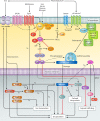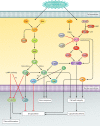The Cryptococcus neoformans capsule: a sword and a shield
- PMID: 22763631
- PMCID: PMC3416491
- DOI: 10.1128/CMR.00001-12
The Cryptococcus neoformans capsule: a sword and a shield
Abstract
The human fungal pathogen Cryptococcus neoformans is characterized by its ability to induce a distinct polysaccharide capsule in response to a number of host-specific environmental stimuli. The induction of capsule is a complex biological process encompassing regulation at multiple steps, including the biosynthesis, transport, and maintenance of the polysaccharide at the cell surface. By precisely regulating the composition of its cell surface and secreted polysaccharides, C. neoformans has developed intricate ways to establish chronic infection and dormancy in the human host. The plasticity of the capsule structure in response to various host conditions also underscores the complex relationship between host and parasite. Much of this precise regulation of capsule is achieved through the transcriptional responses of multiple conserved signaling pathways that have been coopted to regulate this C. neoformans-specific virulence-associated phenotype. This review focuses on specific host stimuli that trigger the activation of the signal transduction cascades and on the downstream transcriptional responses that are required for robust encapsulation around the cell.
Figures






References
Publication types
MeSH terms
Substances
Grants and funding
LinkOut - more resources
Full Text Sources

